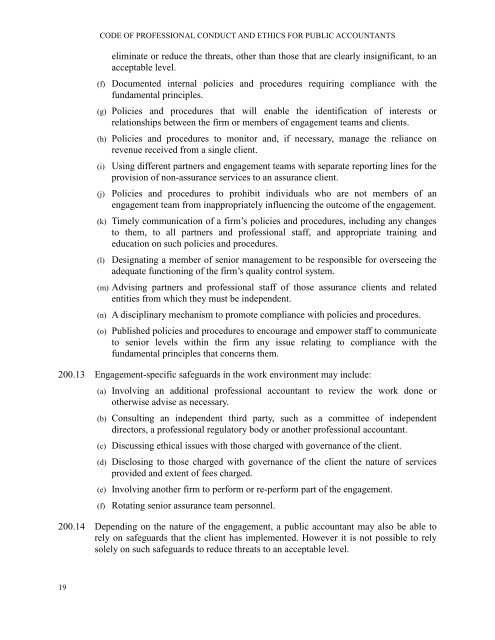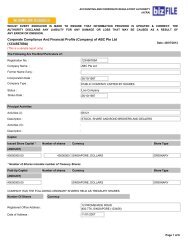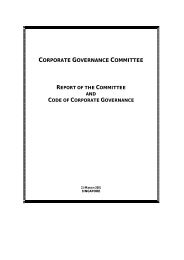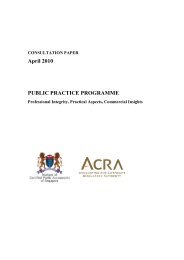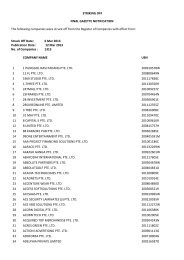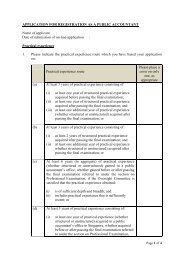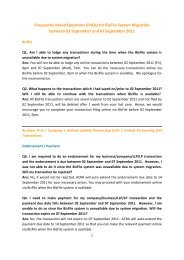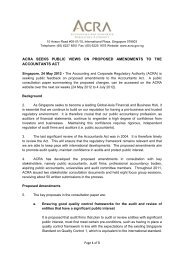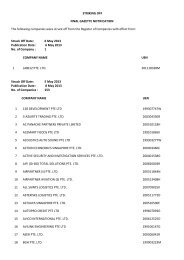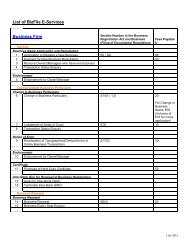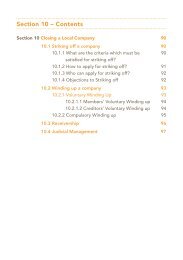Exposure Draft - ACRA
Exposure Draft - ACRA
Exposure Draft - ACRA
Create successful ePaper yourself
Turn your PDF publications into a flip-book with our unique Google optimized e-Paper software.
CODE OF PROFESSIONAL CONDUCT AND ETHICS FOR PUBLIC ACCOUNTANTS<br />
eliminate or reduce the threats, other than those that are clearly insignificant, to an<br />
acceptable level.<br />
(f) Documented internal policies and procedures requiring compliance with the<br />
fundamental principles.<br />
(g) Policies and procedures that will enable the identification of interests or<br />
relationships between the firm or members of engagement teams and clients.<br />
(h) Policies and procedures to monitor and, if necessary, manage the reliance on<br />
revenue received from a single client.<br />
(i) Using different partners and engagement teams with separate reporting lines for the<br />
provision of non-assurance services to an assurance client.<br />
(j) Policies and procedures to prohibit individuals who are not members of an<br />
engagement team from inappropriately influencing the outcome of the engagement.<br />
(k) Timely communication of a firm‘s policies and procedures, including any changes<br />
to them, to all partners and professional staff, and appropriate training and<br />
education on such policies and procedures.<br />
(l) Designating a member of senior management to be responsible for overseeing the<br />
adequate functioning of the firm‘s quality control system.<br />
(m) Advising partners and professional staff of those assurance clients and related<br />
entities from which they must be independent.<br />
(n) A disciplinary mechanism to promote compliance with policies and procedures.<br />
(o) Published policies and procedures to encourage and empower staff to communicate<br />
to senior levels within the firm any issue relating to compliance with the<br />
fundamental principles that concerns them.<br />
200.13 Engagement-specific safeguards in the work environment may include:<br />
(a) Involving an additional professional accountant to review the work done or<br />
otherwise advise as necessary.<br />
(b) Consulting an independent third party, such as a committee of independent<br />
directors, a professional regulatory body or another professional accountant.<br />
(c) Discussing ethical issues with those charged with governance of the client.<br />
(d) Disclosing to those charged with governance of the client the nature of services<br />
provided and extent of fees charged.<br />
(e) Involving another firm to perform or re-perform part of the engagement.<br />
(f) Rotating senior assurance team personnel.<br />
200.14 Depending on the nature of the engagement, a public accountant may also be able to<br />
rely on safeguards that the client has implemented. However it is not possible to rely<br />
solely on such safeguards to reduce threats to an acceptable level.<br />
19


